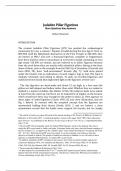Judahite Pillar Figurines
More Questions than Answers
Robert Deutsch
INTRODUCTION
The ceramic Judahite Pillar Figurines (JPF) has puzzled the archaeological
community for over a century.1 Popular in Judah during the Iron Age II, from ca.
800 BCE until the Babylonian destruction of the First Temple in 586 BCE, they
are known as JPFs,2 and over a thousand figurines, complete or fragmentary,
have been found to date in excavations at every tell in Judah containing an Iron
Age strata.3 All JPFs are female, and are referred to as ‘pillar’ figurines because
from the neck down they are mostly solid cylindrical pillars, flaring at the base.
Some of them, such as the example from the Old City of Jerusalem (Yezerski and
Geva 2003, 78), have "well-accentuated" breasts (Fig. 7),4 with arms placed
under the breasts, but no indications of navel, fingers, legs or feet. The back is
similarly schematic and lacking in details. To date, no inscribed figurines and
molds have been found that might shed light on the figurines or their use.5
The clay figurines are hand-made and about 15 cm high; in a few cases the
pillars are bell-shaped and hollow rather than solid. Whether they are naked or
clothed is a matter of debate. Raz Kletter (1996, 50), believes them to be naked,
at least from the waist up; but there are no indications of nipples on the breasts,
which would have been easy enough for the potter to make, as often appears on
other types of naked figurines (Curtis 1995, 82 and cover illustration, and see
Fig. 1 below). In contrast with the accepted concept that the figurines are
represented holding their breast (Darby 2014, 2 and see below), a close
examination reveals that the hands never support the breasts, but are simply
1
The article is based on a paper delivered at the annual meeting of the Society of Biblical Literature in
Baltimore in November 2013. A shortened popular version of the paper titled "JPFs, More Questions
than Answers" was published in the Biblical Archaeological Review Vol. 40, no. 5, September/October
2014, 37-39.
2
The term JPF which originally stood for Judean Pillar Figurines needs to be updated. The area in
which the JPFs were found is Judah, not Judea. It became Judea only later, after the Roman conquest of
the first century C.E., as appears on the “Judaea Capta” coins minted by Emperors Vespasian and Titus
(69 – 81 C.E.). When the term JPF was first coined, it was the scholarly convention to form the
adjective of Judah as Judean. The people of Judah are referred as Judahite; so we will refer to these
figurines as Judahite Pillar Figurines, or simply JPF, as previously.
3
In addition, hundreds of JPFs of unknown provenance have been recorded in public and private
collections (Rahmani 1976, 144; Hachlili and Meshorer, 1986, 38-39; Ornan 1986, 34-35; Kletter
1996, 232-236; Guri-Rimon 2001, 29: Staubli 2007, 56-57; Zemer 2009, 68, etc.).
4 Term coined by Kathleen M. Kenyon (1967, 141).
5 In this respect we can mention the 8th or 7th century BCE unprovenanced bronze naked female
figurine from the Seville archaeological museum, which bears a dedicatory Phoenician inscription on
its base mentioning Astarte Ḥor (Cross 1971).
, resting on the pillar below the breast, or even on the waist (Kletter 1996, 29).
More significantly, no JPFs are recorded with any indication of pudenda on the
body. The JPFs were whitewashed and painted after firing, with remnants of
paint present also on the pillar/body.
In contrast with the somewhat similar figurines from the Late Bronze and Iron
Age (1500–700 B.C.E.),6 in Israel and nearby areas, which exhibit both the
figurine’s sexuality prominently and the gesture of cupping the naked breasts
(Figs. 1-3), this seems to suggest that the JPFs are most probably clothed.7
Fig. 1. Megiddo Fig. 2. Susa Fig. 3. Nimrud
Late Bronze Age Late Bronze Age Iron Age 8th century BCE
(© The Trustees of the
British Museum ME91823)
6
Megiddo Cult, Pl. XXXI, fig. 598; Quarantelli et al., 1985, 329-330, 402-404, nos. 173-174; Beck
2002, 437-446, (439, fig. 2); Sugimoto 2008; Hunziker-Rodewald 2014.
7
However, recently Michael Press follows Kletter (1996, 50), and states that the JPFs "are always
depicted as nude or at least with a nude torso" (Press 2012, 205),




